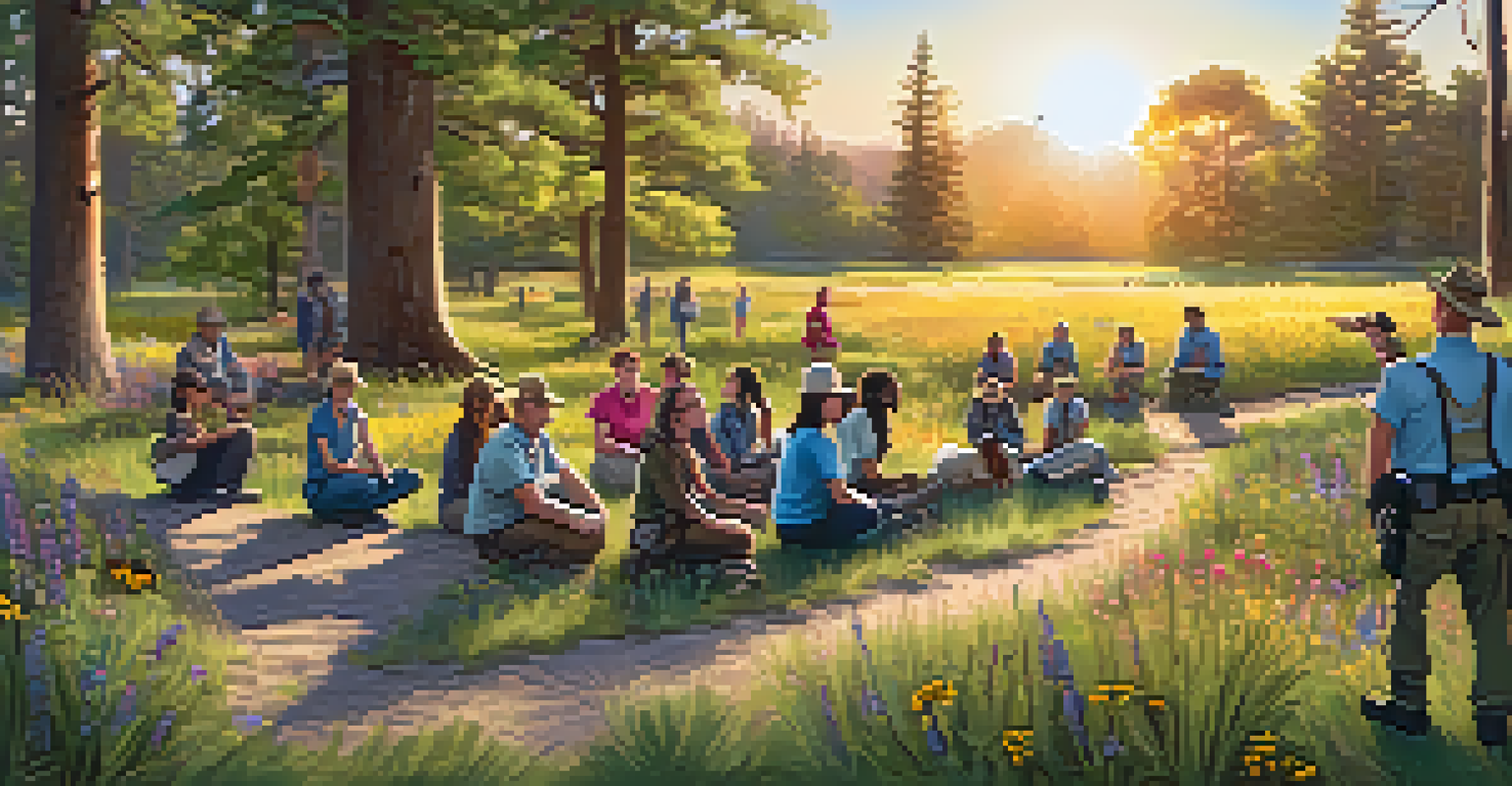How to Stay Safe from Wildlife While Traveling

Understanding Wildlife Behavior Can Keep You Safe
Wildlife can be unpredictable, and understanding their behavior is your first line of defense. Animals are often more scared of you than you are of them, but when they feel threatened, their instincts can kick in. For instance, a mother bear with cubs may become very protective if she perceives any danger. By recognizing signs of animal stress, like huffing or stomping, you can avoid escalating a situation.
The clearest way into the Universe is through a forest wilderness.
Different species have unique behaviors; knowing these can help you avoid risky encounters. For example, deer usually flee at the first sign of human presence, while raccoons may be more curious but can carry diseases. If you’re hiking, keeping a safe distance and observing from afar can help you appreciate wildlife without putting yourself at risk.
Always remember that wildlife is best left wild. Feeding animals can alter their natural behavior, making them more aggressive or dependent on humans for food. By respecting their space and keeping your distance, you can enjoy observing wildlife while ensuring your safety.
Plan Your Activities with Wildlife in Mind
When planning your trip, take some time to research the local wildlife in the area you'll be visiting. Different regions have different animals, and knowing what to expect can help shape your itinerary. For instance, if you’re heading to a national park known for its bear population, consider adjusting your camping location to avoid high-traffic areas.

Consider scheduling excursions during times when wildlife is less active. Many animals are most active during dawn and dusk, so planning your hikes or activities during the middle of the day can reduce your chances of an encounter. Additionally, guided tours often come with experienced leaders who can help you navigate wildlife safely.
Understand Wildlife Behavior
Recognizing animal stress signals and understanding species-specific behaviors can help you avoid dangerous encounters.
Ultimately, being aware of your surroundings and planning accordingly can create a more enjoyable and safer travel experience. Don't forget to share your plans with travel companions, ensuring everyone is on the same page regarding safety protocols.
Keeping Food Secure to Avoid Wildlife Encounters
One of the most significant attractants for wildlife is food. When camping or traveling in nature, proper food storage is crucial for your safety. Always use bear-proof containers or hang your food high in trees to keep it away from curious critters. Even small animals like raccoons can be surprisingly adept at getting into improperly stored food.
Wildlife conservation is not just about saving animals, it's about saving ourselves.
Consider using odor-proof bags to further reduce the scent of food, which can entice animals. Cooking away from your sleeping area is also a good practice, as it minimizes the chance of attracting unwanted visitors at night. Remember, a clean campsite not only keeps wildlife away but also makes your trip more enjoyable.
If an animal does approach your camp, do not attempt to feed it or scare it away yourself. Instead, make noise from a safe distance to encourage it to leave. The goal is to keep both yourself and the wildlife safe, as interactions can be dangerous for both parties.
Staying Alert: Watch for Signs of Wildlife Nearby
While you’re out exploring, staying alert can be your best defense against unexpected wildlife encounters. Keep your eyes peeled for tracks, droppings, or other signs that animals are nearby. This awareness can help you gauge how close you might be to wildlife and allow you to take precautions if necessary.
Listening is just as important as watching. Many animals will make sounds that can alert you to their presence long before you see them. The rustling of leaves or a branch snapping can signal that you’re not alone, giving you a chance to either retreat or prepare for a safe encounter.
Secure Food to Prevent Encounters
Properly storing food and maintaining a clean campsite is essential to avoid attracting wildlife.
By integrating these practices into your travels, you not only protect yourself but also deepen your connection with nature. Being present and aware enhances your outdoor experience, allowing for memorable moments while prioritizing safety.
Using Proper Gear to Enhance Your Safety
Equipping yourself with the right gear can significantly enhance your safety during wildlife encounters. Items like bear spray can be a deterrent in case of close encounters with larger animals. While it’s not something you want to rely on, having it within reach can provide peace of mind.
Investing in noise-making devices, such as bells or whistle, can also help alert nearby wildlife to your presence. This is particularly useful when hiking in dense forest areas where visibility is limited. The noise can often prompt animals to move away before you even see them.
Lastly, wearing bright colors can make you more visible, which can help animals recognize you as a human rather than a potential threat. While the goal is to blend in with nature, ensuring you’re seen can help minimize surprise encounters.
Traveling with Pets: Special Considerations
When traveling with pets, additional precautions are necessary to keep both your furry friend and wildlife safe. Many wildlife encounters can escalate quickly if pets are involved, so always keep them on a leash and under control. This not only protects your pet but also helps prevent wildlife from feeling threatened.
Make sure to research pet policies in the areas you plan to visit. Some national parks and nature reserves do not allow pets due to wildlife sensitivities. Understanding these rules will help you avoid fines and ensure a safe environment for both your pets and local wildlife.
Stay Educated for Safety
Learning about local wildlife and their behaviors equips you with the knowledge needed to safely enjoy nature.
Lastly, ensure your pet is up-to-date on vaccinations, as they may encounter wildlife that could carry diseases. Being prepared will let you relax and enjoy your travels, knowing you’ve taken the necessary steps for safety.
Recognizing When to Seek Help or Leave the Area
Even with all precautions in place, there may be times when wildlife encounters feel unsettling or dangerous. Understanding when to seek help is crucial. If you spot an animal behaving unusually—like showing aggression or staying too close—it's best to leave the area calmly and slowly, avoiding sudden movements.
If you find yourself in a situation where an animal is blocking your path or approaching, do not hesitate to contact park rangers or local wildlife authorities. They are trained to handle such situations and can provide guidance tailored to the specific wildlife in the area.

Listening to your instincts is key. If something feels off, it’s always better to err on the side of caution. Prioritize your safety and the well-being of the wildlife by knowing when it’s time to step back.
Educating Yourself: The Best Form of Prevention
One of the most effective ways to stay safe from wildlife encounters is through education. Before you travel, take the time to learn about the local wildlife and their behaviors. Many parks and wildlife organizations offer resources that can help you understand how to interact safely with animals.
Consider participating in workshops or ranger-led programs that focus on wildlife safety. These experiences can provide invaluable information and practical tips, allowing you to engage with nature responsibly and knowledgeably. Plus, you may even meet fellow travelers who share your interests!
Remember, knowledge is power, and being informed not only enhances your travel experience but also helps preserve the natural habitats you’re visiting. By educating yourself, you’re taking a proactive approach to ensuring your safety and that of the wildlife.